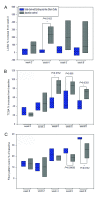Fetal derived embryonic-like stem cells improve healing in a large animal flexor tendonitis model
- PMID: 21272343
- PMCID: PMC3092144
- DOI: 10.1186/scrt45
Fetal derived embryonic-like stem cells improve healing in a large animal flexor tendonitis model
Abstract
Introduction: Tendon injury is a common problem in athletes, with poor tissue regeneration and a high rate of re-injury. Stem cell therapy is an attractive treatment modality as it may induce tissue regeneration rather than tissue repair. Currently, there are no reports on the use of pluripotent cells in a large animal tendon model in vivo. We report the use of intra-lesional injection of male, fetal derived embryonic-like stem cells (fdESC) that express Oct-4, Nanog, SSEA4, Tra 1-60, Tra 1-81 and telomerase.
Methods: Tendon injury was induced using a collagenase gel-physical defect model in the mid-metacarpal region of the superficial digital flexor tendon (SDFT) of eight female adult Thoroughbred or Thoroughbred cross horses. Tendon lesions were treated one week later with intra-lesional injection of male derived fdESCs in media or media alone. Therapy was blinded and randomized. Serial ultrasound examinations were performed and final analysis at eight weeks included magnetic resonance imaging (MRI), biochemical assays (total DNA, glycosaminoglycan, collagen), gene expression (TNC, TNMD, SCX, COL1A1, COL3A1, COMP, DCN, MMP1, MMP3, MMP13, 18S) and histology. Differences between groups were assessed with Wilcoxon's rank sum test.
Results: Cell survival was demonstrated via the presence of the SRY gene in fdESC treated, but not control treated, female SDFT at the end of the trial. There were no differences in tendon matrix specific gene expression or total proteoglycan, collagen or DNA of tendon lesions between groups. Tissue architecture, tendon size, tendon lesion size, and tendon linear fiber pattern were significantly improved on histologic sections and ultrasound in the fdESC treated tendons.
Conclusions: Such profound structural effects lend further support to the notion that pluripotent stem cells can effect musculoskeletal regeneration, rather than repair, even without in vitro lineage specific differentiation. Further investigation into the safety of pluripotent cellular therapy as well as the mechanisms by which repair was improved seem warranted.
Figures






References
-
- Sharma P, Maffulli N. Biology of tendon injury: healing, modeling and remodeling. J Musculoskelet Neuronal Interact. 2006;6:181–90. - PubMed
Publication types
MeSH terms
Substances
LinkOut - more resources
Full Text Sources
Other Literature Sources
Medical
Research Materials
Miscellaneous

